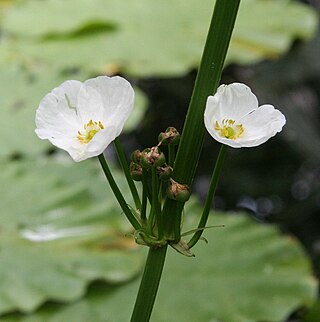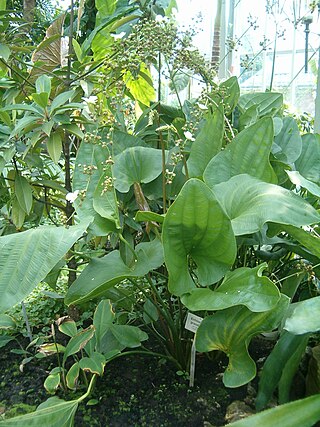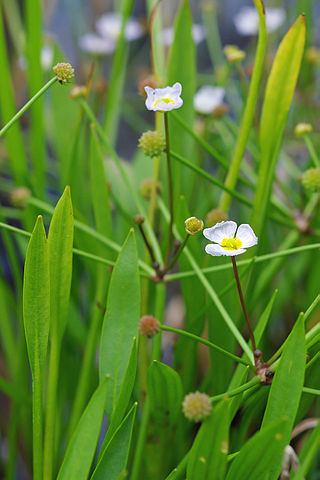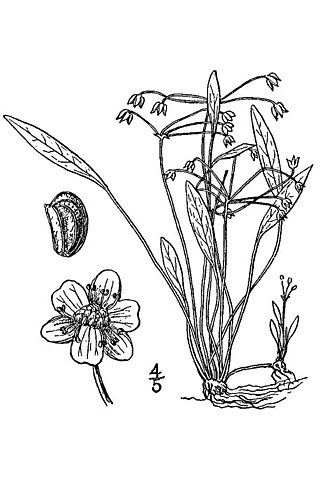
Echinodorus, commonly known as burhead or Amazon sword, is a genus of plants in the family Alismataceae, native to the Western Hemisphere from the central United States to Argentina. Its scientific name is derived from Ancient Greek echius – "rough husk" - and doros – "leathern bottle" - alluding to ovaries, which in some species are armed with persistent styles, forming prickly head of fruit. Some of the species are commonly cultivated in artificial aquatic habitats.
Echinodorus horizontalis is a species of plant in the Alismataceae family. It is native to northern South America.
Echinodorus tunicatus is a species of aquatic plants in the family Alismataceae.
Echinodorus pubescens is a species of aquatic plant in the family Alismataceae. Rataj places it in his Section Paniculati - Subgenus Echinodorus

Echinodorus subalatus is a species of aquatic plants in the Alismataceae. It is native to Cuba, Mexico, Central America, Guyana, Venezuela, Bolivia, Brazil and Paraguay. It is found naturally growing in mud by the side of streams.

Echinodorus uruguayensis or Echinodorus osiris is a plant species in the Alismataceae. It is native to South America.

Echinodorus berteroi is an aquatic plant species in the Alismataceae It is native to the southern and central parts of the United States, as well as Central America, the West Indies, and South America as far south as Argentina.

Echinodorus grandiflorus is a plant species in the Alismataceae. It is native to Brazil, Paraguay, Uruguay, Argentina, Venezuela and Florida.

The Botanische Garten der Martin-Luther-Universität Halle-Wittenberg is an arboretum and botanical garden maintained by the University of Halle-Wittenberg. It is located at Am Kirchtor 3 in the city of Halle, Saxony-Anhalt, Germany, and open daily in the warmer months. An admission fee is charged.

Diplaziopsidaceae is a family of ferns in the order Polypodiales. In the Pteridophyte Phylogeny Group classification of 2016 (PPG I), the family is placed in the suborder Aspleniineae, and includes two genera. Alternatively, it may be treated as the subfamily Diplaziopsidoideae of a very broadly defined family Aspleniaceae.
Elophila difflualis is a moth of the family Crambidae. The species was first described by Pieter Cornelius Tobias Snellen in 1880. It is found in South-East Asia, in Australia and Réunion but has also be introduced to the United Kingdom.

Echinodorus palifolius, also known as Mexican sword plant is an emerged aquatic plant in the Alismataceae. It has a rather odd, discontinuous range, native to Brazil, Peru, Uruguay, and Mexico (Nayarit). It has been introduced in many countries including Bangladesh and India.

Baldellia ranunculoides, the lesser water-plantain, is a species of flowering plant in the family Alismataceae.

Helanthium is a genus of plants in the Alismataceae, native to the Western Hemisphere. At present, three species are recognized:

Helanthium tenellum, the pygmy chain sword, is a species of plants in the Alismataceae. It is native to the eastern United States, southern Mexico, West Indies, Central America, South America

Helanthium bolivianum is a species of plant in the Alismataceae. It is native to southern Mexico, Central America, the West Indies and South America.
Helanthium zombiense is a species of plants in the Alismataceae. It is native to the islands of Jamaica and Guadeloupe in the West Indies.

Echinodorus grisebachii or Echinodorus amazonicus is commonly known as Amazon sword plant, although other plants are also known under this common name. The aquatic plant is cultivated for and used in ponds and artificial aquatic habitats. It is native to Cuba, Central America, and South America as far south as Brazil and Bolivia. It has been sold under the name Paniculatus.
Echinodorus reptilis is a species of plant in the Alismataceae from South America.












